There
are three classical theories of meaning:
-analytical
or referential
(F.de
Saussure’s disciples)
Meaning
is the relation between the object or phenomenon named and the name
itself;
-notional
or
conceptual (Aristotle,
John Locke, A.I. Smirnitskiy, etc.)
Meaning
is a certain representation
of an object / phenomenon / idea / relation in the mind;
—functional
or
contextual (L. Bloomfield)
Meaning
is the situation in which a word is uttered, i.e. its context.
22. Types and aspects of word meaning.
Aspects
of Meaning
-Objective
aspect (denotation): word ↔ referent;
-Notional
aspect, i.e. significant features common for classes of objects
(signification): word ↔ sense;
-Pragmatic
aspect, i.e. the speaker’s attitude to the referent (connotation);
-Systemic
or differential aspect, i.e. the relations of the signified word with
other words within a word-group or in speech.
Types
of meaning:
Word-meaning
is not homogeneous but is made up of various components the
combination and the interrelation of which determine to a great
extent the inner facet of the word.
Grammatical
meaning
is the meaning which unites words into big groups such as parts of
speech or lexico-grammatical classes. It is recurrent in identical
sets of individual forms of different words, e.g. stones,
apples, kids, thoughts have
the grammatical meaning of plurality.
Lexical
meaning
is the meaning proper to the word as a linguistic unit; it is
recurrent in all the forms of this word and in all the possible
distributions of these forms, e.g. the word-forms write,
writes,
wrote,
writing,
written
have different grammatical meanings of tense, person, aspect, but the
same lexical meaning ‘to make letters or other symbols on a
surface, especially with a pen or pencil’.
Components
of Lexical Meaning
Lexical
meaning is not homogenous either and may be analysed as including
denotative and connotative components.
Denotative
(denotational) (Lat. denotatum
‘signified’) component is the conceptual content of the word
fulfilling its significative and communicative functions; our
experience is conceptualised and classified in it.
Connotative
(connotational) (Lat. connoto
‘additional meaning’) component conveys the speaker’s attitude
to the social circumstances and the appropriate functional style,
one’s approval or disapproval of the object spoken of, the
speaker’s emotions, the degree of intensity; unlike
denotations or significations, connotations are optional.
Types
of Connotations
Stylistic
connotation
is concerned with the situation in which the word is uttered, the
social circumstances (formal, familiar), the social relationships
between the communicants (polite, rough etc.), the type and purpose
of communication, e.g. father
(stylistically neutr.), dad
(colloquial), parent
(bookish).
Emotional
connotation
is acquired by the word as a result of its frequent use in contexts
corresponding to emotional situations or because the referent
conceptualised in the denotative meaning is associated with certain
emotions, e.g. mother
(emotionally neutr.), mummy
(emotionally charged); bright
(emotionally
neutr.), garish
(implies negative emotions).
Evaluative
connotation
expresses approval or disapproval, e.g. modern
is often used appreciatively, newfangled
expresses disapproval.
Intensifying
connotation
expresses degree of intensity, e.g. the words magnificent,
gorgeous, splendid, superb
are used colloquially as terms of exaggeration.
Соседние файлы в предмете [НЕСОРТИРОВАННОЕ]
- #
- #
- #
- #
- #
- #
- #
- #
- #
- #
- #
Слайд 1The Word
Definitions and Interpretations
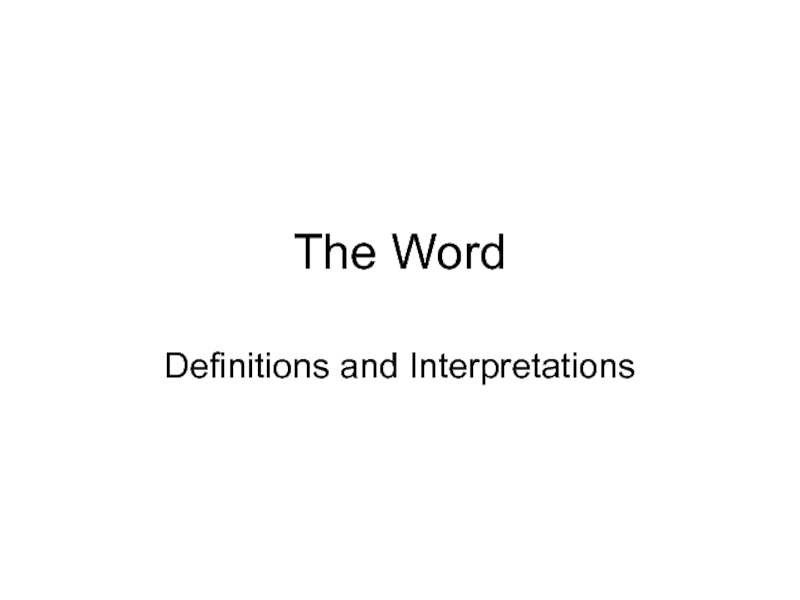
Слайд 2Difficulties in the definition of the word
There are a lot
of definitions of the word. It is hard to find a satisfactory one. On the other hand, people have no difficulties in recognizing words of their native language. Below are three definitions which emphasize different aspects of word:
A sequence of letters separated by spaces on both sides.
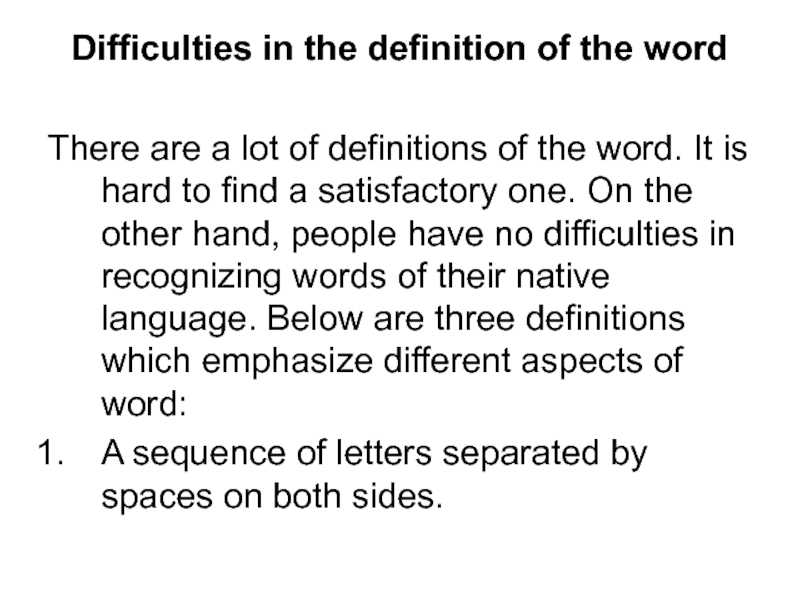
Слайд 3 2. An indivisible unit of thought.
3. The minimal free
form. (Bloomfield)
Distinction should be made between orthographic words, phonological words, word forms and lexemes.
Lexeme is the smallest distinctive unit in the lexicon of a language. The term was introduced to avoid the ambiguity of the term “word’. Lexeme subsumes a range of variant grammatical forms (go – going — goes).
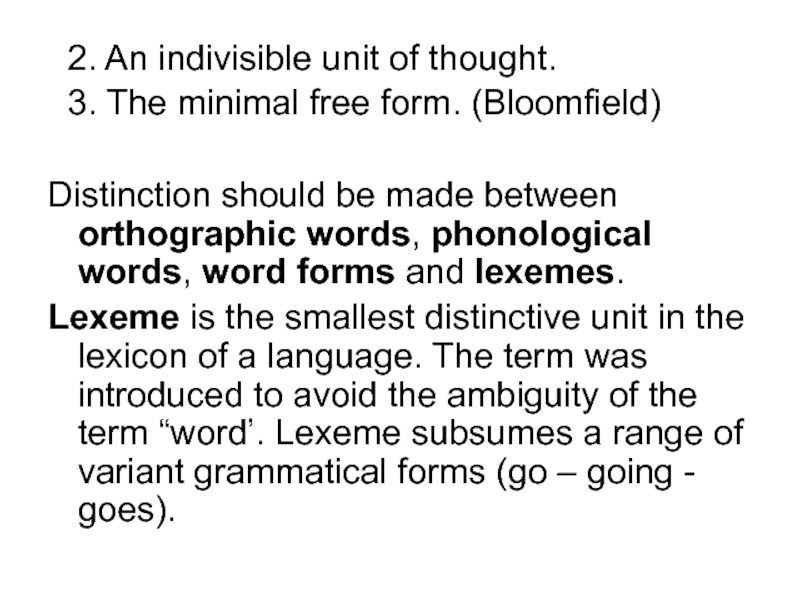
Слайд 4Count the words in the following sentence:
You can’t tie a bow
with the rope in the bow of a boat. (Jackson 1988:1)
The most straightforward answer — 14 words.
can’t ?
Some words occur more than once (a, the)
Bow (two or one)?
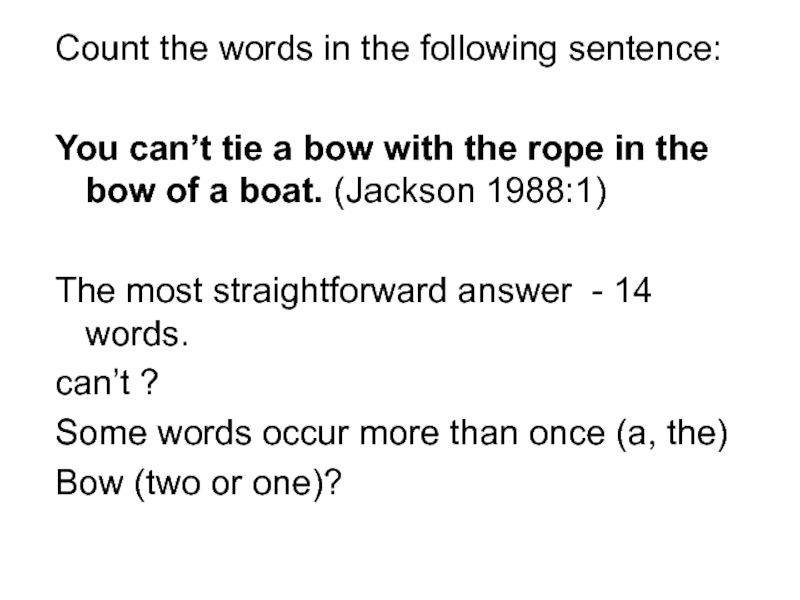
Слайд 5bow 1 [beu]– kilpa
bow 2 [bau] – laivo priekis
The
answer:
There are 11 different orthographic words, with two instances each of a, the and bow.
There are 12 different phonological words, with two instances each of the indefinite and the definite articles.
There are 13 different word forms (grammatically can and not are distinct word forms)
![The Word. Definitions and Interpretations bow 1 [beu]– kilpa bow 2 [bau] – laivo priekis The bow 1 [beu]– kilpa bow 2 [bau] – laivo priekis The answer: There are 11](https://thepresentation.ru/img/tmb/6/512772/aecff282dcba73233057aff8fe682ed7-800x.jpg)
Слайд 6
There are 13 different lexemes. (the two instances of bow are
two distinct lexemes since they carry different meanings and get separate entries in a dictionary)
Lexemes appear as headwords of dictionary entries.
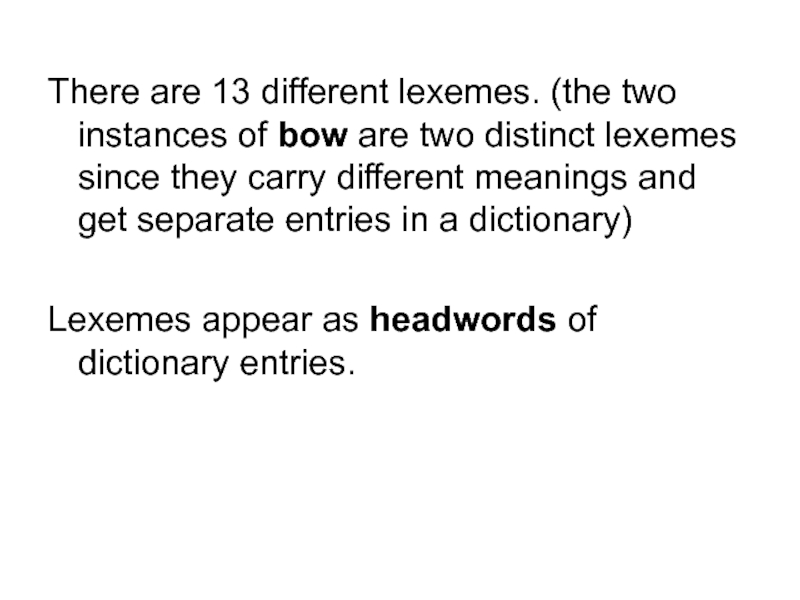
Слайд 7Four characteristics of words
The word is an uninterruptible unit. Elements are
added to the beginning or end and are never included within the word.
The word may consist of one or more morphemes. When a word consists of more than one morpheme, it may be complex or compound. Complex – can be broken into one free and one or more bound morphemes. Compound words consist of more than one free form.
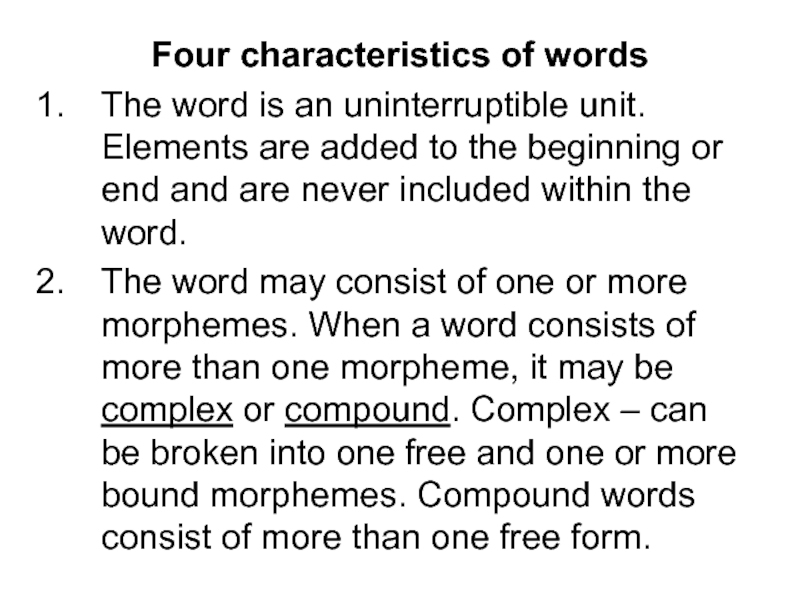
Слайд 8It is not always easy to recognize morphemes – woman, cupboard,
breakfast historically compound words, but now are unanalysable in to morphemes.
3. The word occurs typically in the structure of phrases. Morphemes are used to build words and words are used to build phrases, phrases – to build clauses.
4. Each word should belong to a specific word class or part of speech.
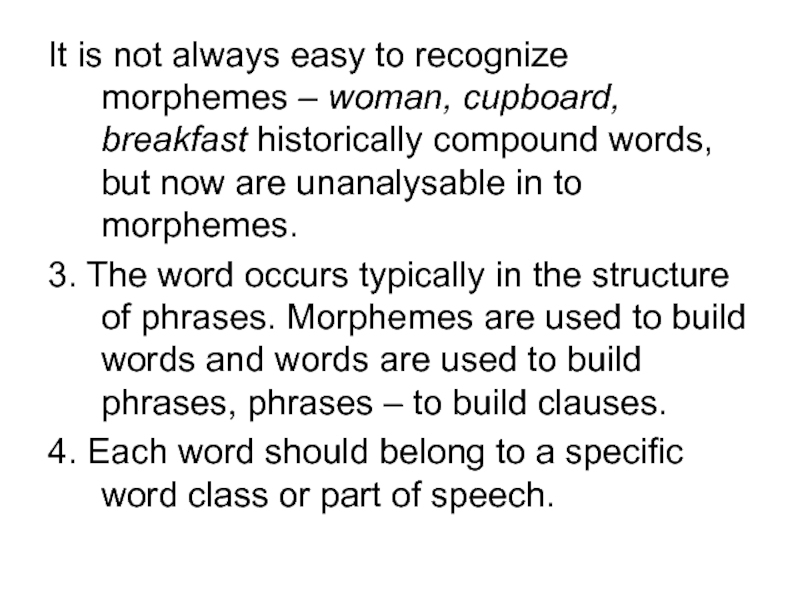
Слайд 9Ambiguity in the notion of word
The most important sources of ambiguity
of word are four:
1.The generic character of the word. Words denote not single items but classes of things or entities. There is always a certain amount of generalization, which inevitably involves an element of vagueness. E. g. chair (what makes a chair a chair? Number of legs? Function?)
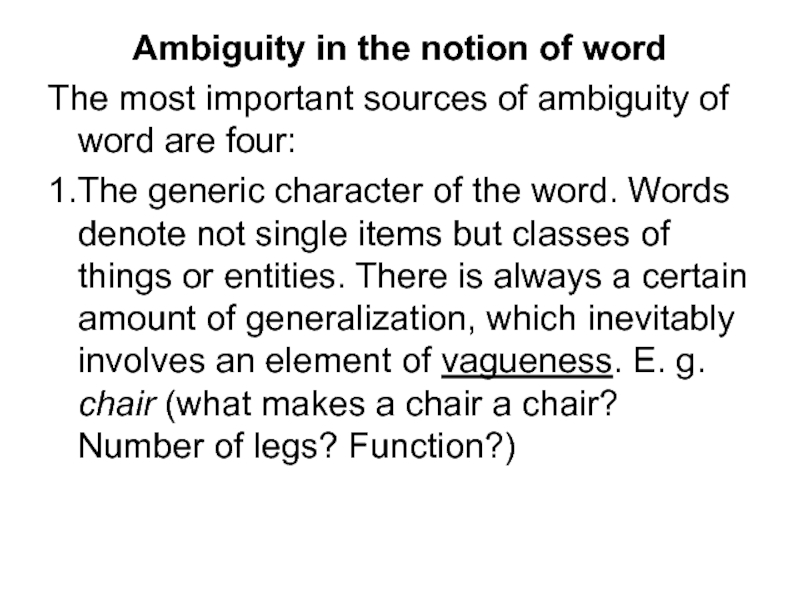
Слайд 102. The multiple aspects of every word.
We have to discriminate between
distinctive and non-distinctive features of words. E.g. table (the color, shape, material are not essential).
3. The lack of clear-cut boundaries in the world.
The nature of the non-linguistic world itself may be a source of ambiguity. One phenomenon may merge into another. E.g. color spectrum is a continuum. But each language divides it into a certain amount of arbitrary distinctions
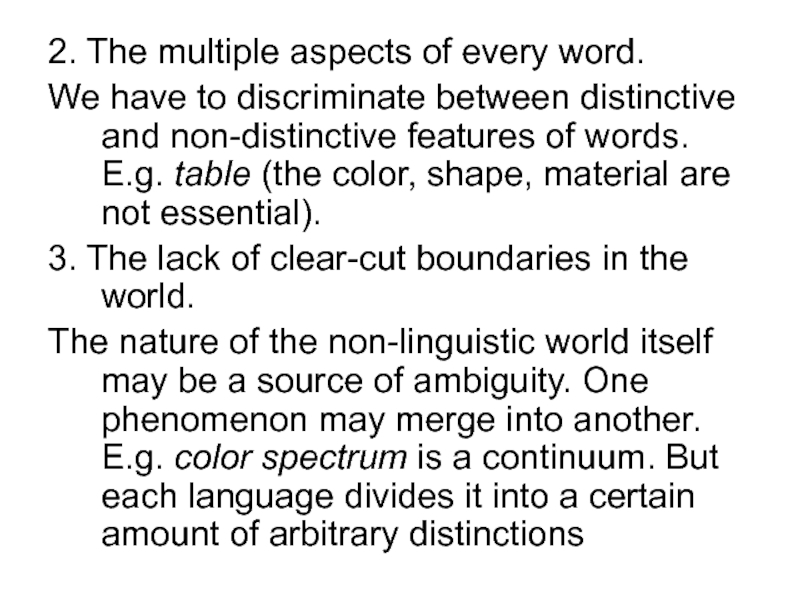
Слайд 114. Lack of familiarity with the referent of a word. General
knowledge and specific interests of individuals. E.g. agricultural terms, computer terms, linguistic terms, etc.
Emotive overtones – word expresses emotions or arouses them in others. This may be opposed to the communicative/informative use of language, but may be even dominant in an utterance (He is bad.)
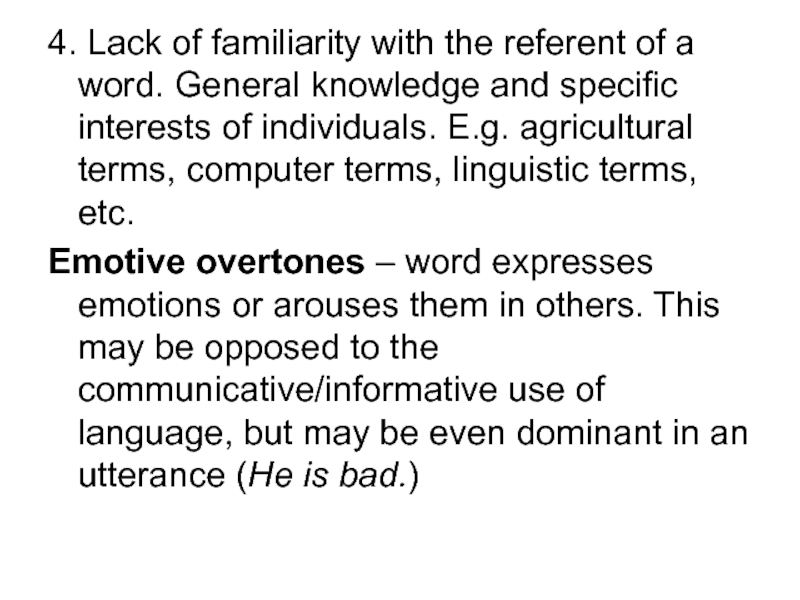
Слайд 12Word meaning
The word as a linguistic sign consists of meaning and
form
referent, concept, form
Denotation – the relation between a lexeme and a whole class of extra-linguistic objects.
Reference – the relation between word and what it stands for in a particular context.
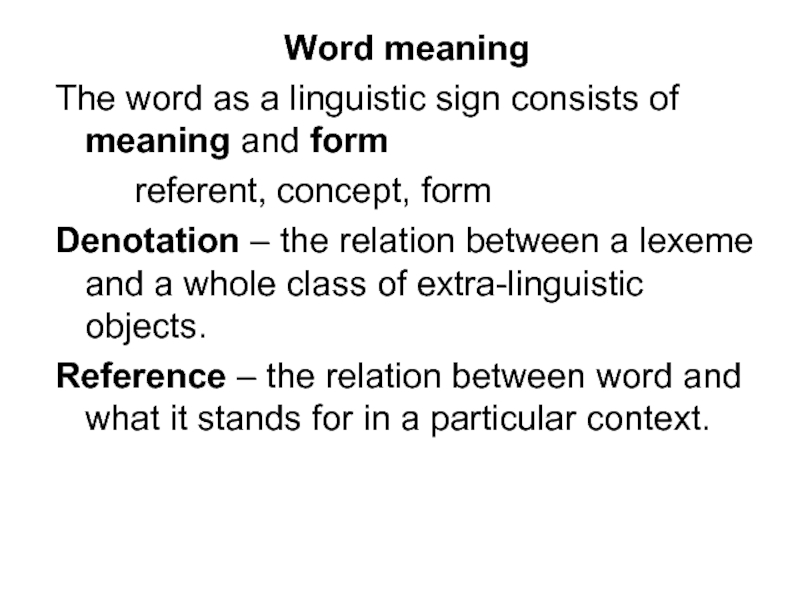
Слайд 13Sense – meaning relations within language There may be words that
have sense but no denotation (unicorn, dragon)
Denotation and connotation
There is no universal treatment of the distinction between these two types of meaning. Connotations make additional properties of lexemes – poetic, slang, emotive, humorous, etc.
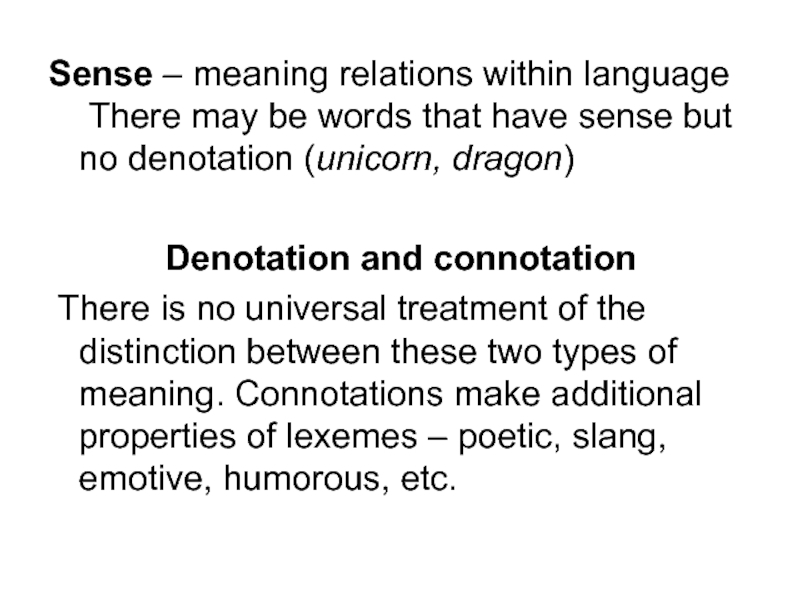
Слайд 14Connotation – the associations that a word has over and above
its denotation. Linguistically significant are the associations that a word carries for a whole language community, e.g. caviar denotes luxury, high class, money, candle – religious or romantic connotations.
The noun woman is defined conceptually by three features: HUMAN, FEMALE ,ADULT but there is a multitude of additional features that we have learned to expect of the referent — psychological and social properties (experienced in cookery, gregarious, likes to dress nicely, is prone to tears).
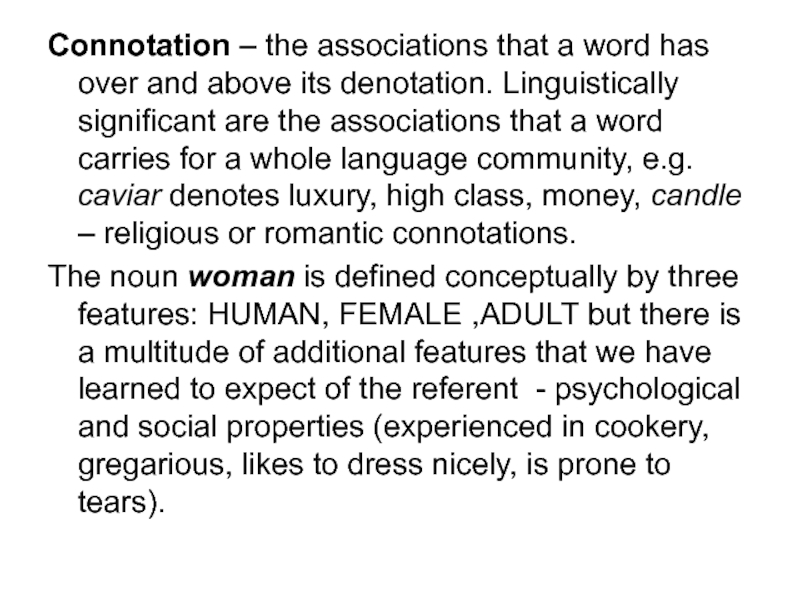
Слайд 15Hollywood denotes an area of LA known as the center of
American movie industry, but connotes glamour, glitz and stardom.
Thus connotation is a non-central word meaning acquired through frequent associations. Connotation is closely related with synonymy since synonyms may have the same denotation but different connotations. Both aspects are important in determining word meaning in a given context.
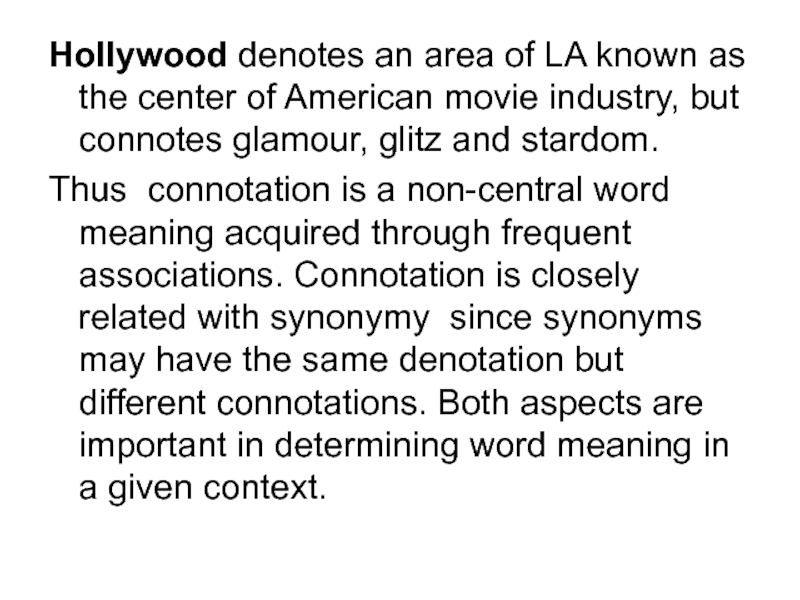
Слайд 16The referential meaning of a lexeme is its denotation and connotation.
It depends on the context in which the lexeme is used. The context is of two kinds: linguistic (the sentence, the text) and situational (extralinguistic).
The definitions of lexemes given in dictionaries cannot provide all the aspects of its meaning. Thus the meaning of a lexeme (its sense) in a dictionary entry must be regarded as “potential”, a distillation of the essentials (Jackson 1988: 60) . It is actualized in a particular context.
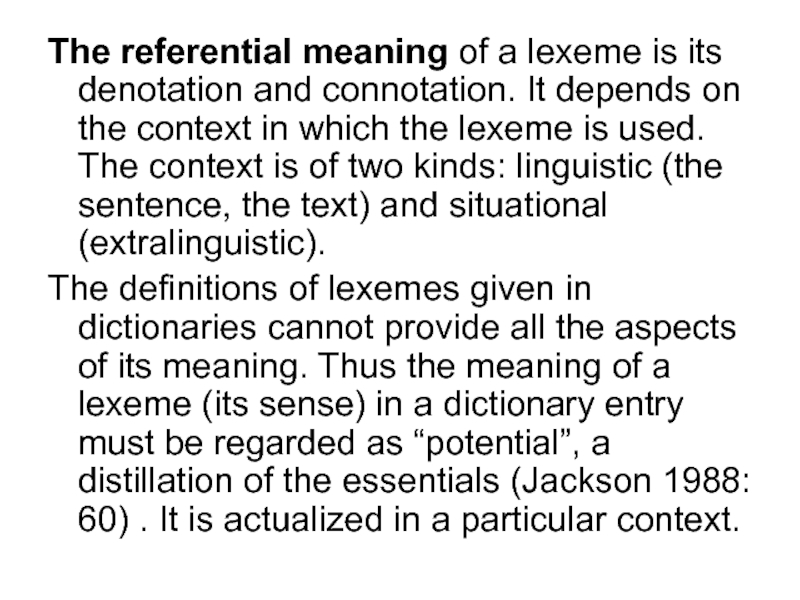
Слайд 17Salt – a natural white mineral added to food to make
it taste better (Longman 2007)
Salt – a very common colorless or white solid substance [sodium chloride] found in the Earth and in sea water and with many used including preserving food and improving the taste (Longman 1978)
Salt –sodium chloride, NaCl, a white crystal like substance found in natural beds, in sea water, etc., used for seasoning and preserving food, etc. (Webster 1980)
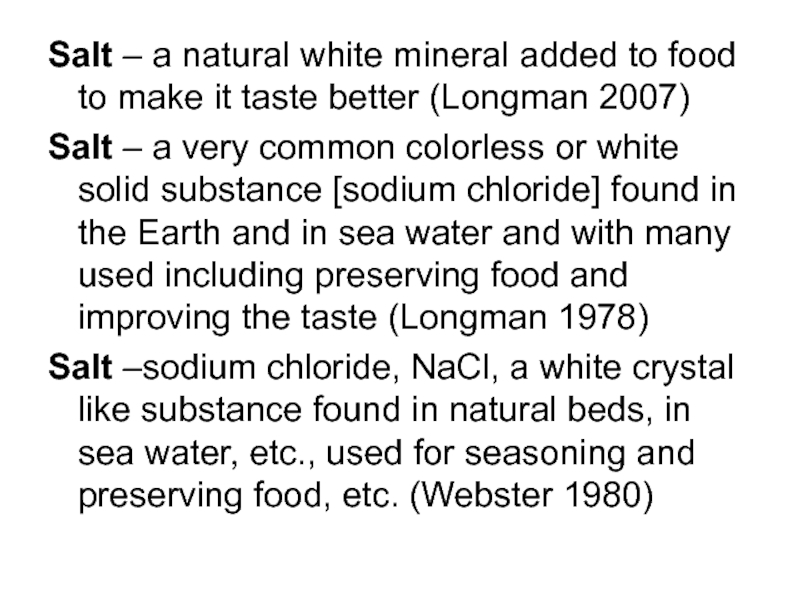
Слайд 18Multiword Lexemes
Definition of lexeme (Jackson and Ze Amvela 2001: 63): it
is a unit of lexical meaning which exists regardless of inflectional endings or the number of words it may contain.
The definition implies that a lexeme may consist of more than one word.
Three types of multiword lexemes:
Phrasal and prepositional words.
Idioms. 3. Some compounds.
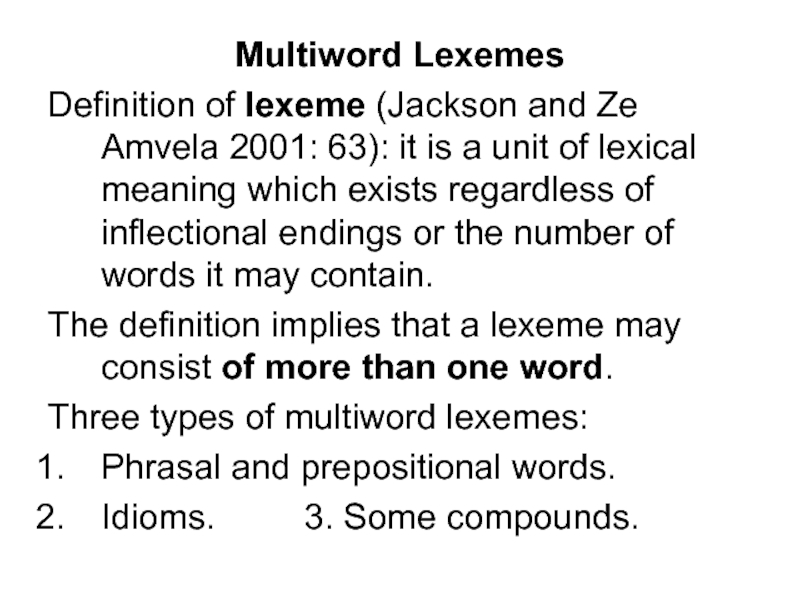
Слайд 19Multiword verbs
These are phrasal verbs, prepositional verbs and phrasal-prepositional verbs.
The clues
that help to distinguish the three groups are transitivity, the position of the direct object and the number of particles used with the verb.
look up
look after
look forward to
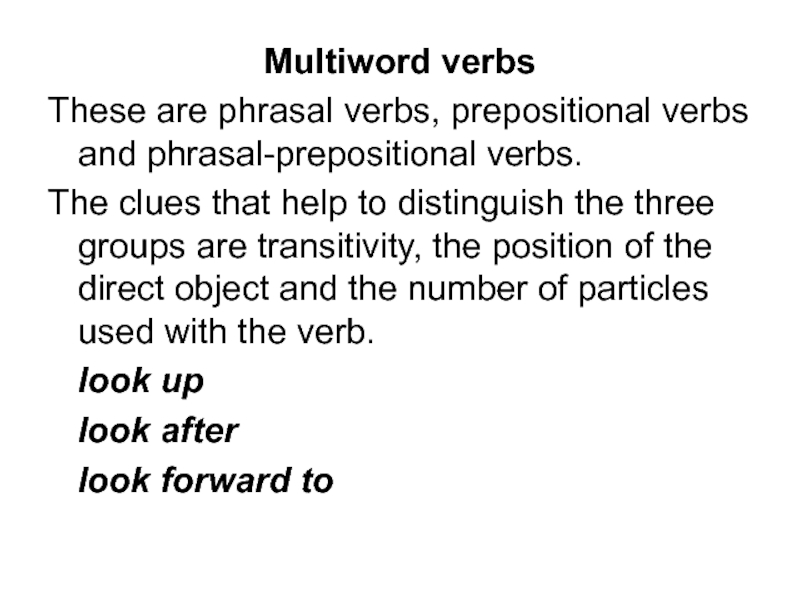
Слайд 20Prepositional verbs are always transitive, i.e. they always take the direct
object. The preposition must go before the direct object.
Mary looks after the little boy.
Mary looks after him.
2. Phrasal verbs can be transitive or intransitive. Transitive:
Jane has put off the party.
Jane has put the party off.
Jane has put it off.
The object may occur after the main verb or after the particle. Personal pronouns cannot precede the particle.
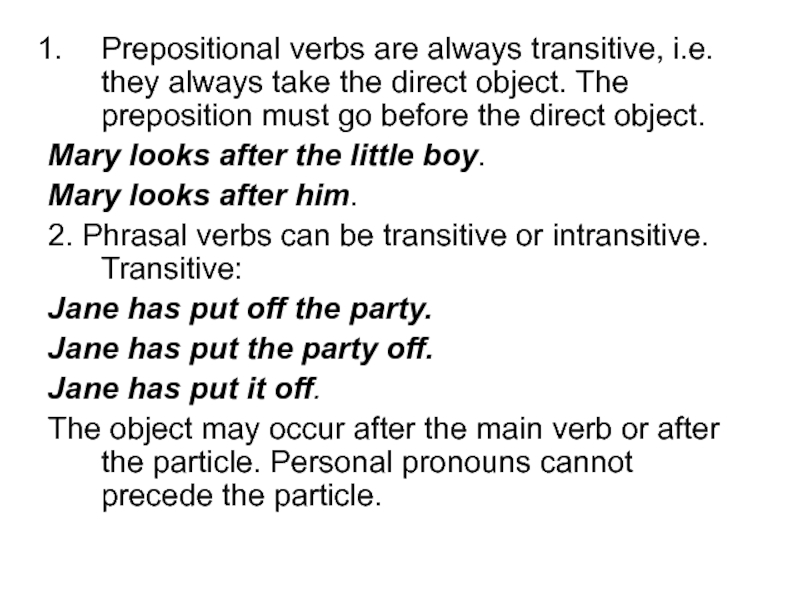
Слайд 21Intransitive:
Get up at once.
Won’t you sit down?
He will never give in.
The
firm provides its workers with uniforms.
Phrasal verbs vary in the extent to which they preserve the meanings of the verb and the particle. The following examples are idiomatic:
give in –”surrender”
turn up – “appear”
drop in – “come for a short visit”
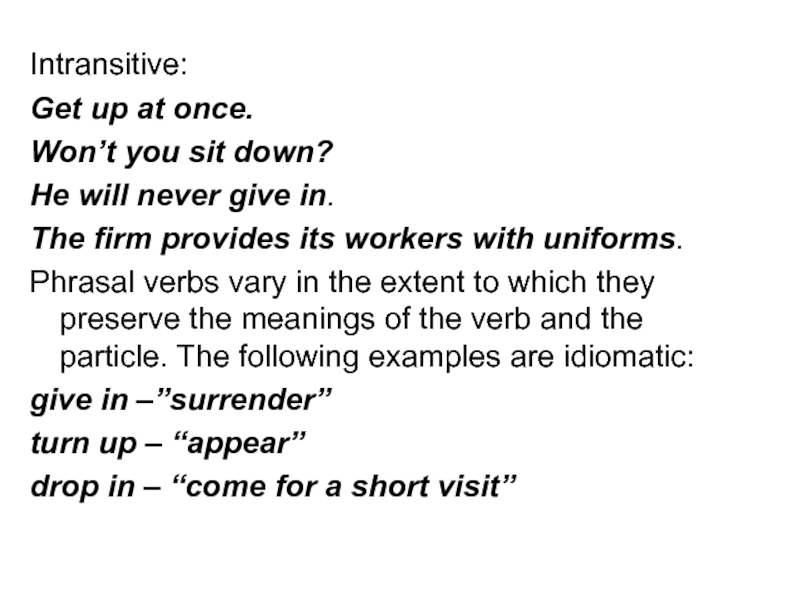
Слайд 223. Prepositional phrasal verbs
put up with – “tolerate”
look down on – “despise”
rub up against – “ keep touching smith”
stand up for – “to support someone”
These are also more or less idiomatic in their meaning.
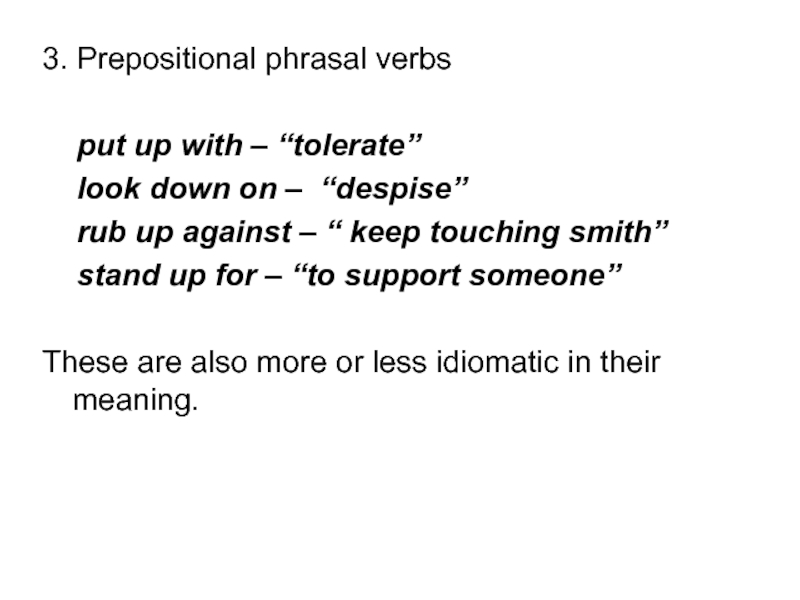
Слайд 23Idioms
Idioms consist of more than one word. The meaning of an
idiom cannot be predicted from of the sum of the meaning of words that make it up. Thus idioms are primarily units of meaning and are treated as multi word lexemes.
to smell the rat
to take the bull by the horns
to hit the nail right in the head
to fly off the handle
out of the blue
a fine kettle of fish
in a hole
to call a spade a spade
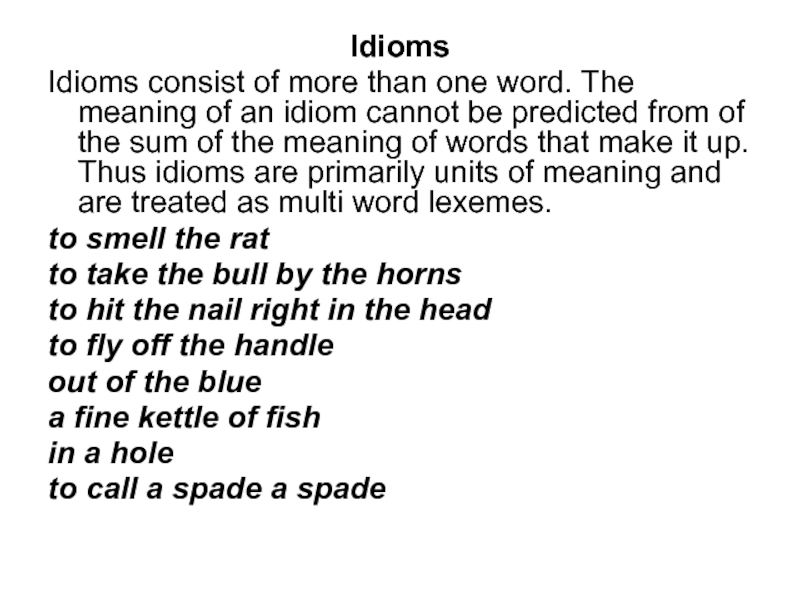
Слайд 24Idioms are often called “frozen metaphors”. They are fixed expressions. The
native speakers may use idioms without considering their metaphorical origin.
Some idioms are only partially idiomatic in the sense that some words in them preserve their original non-metaphoric meaning.
to make bed to fall in love
white coffee white people
red hair blue grass
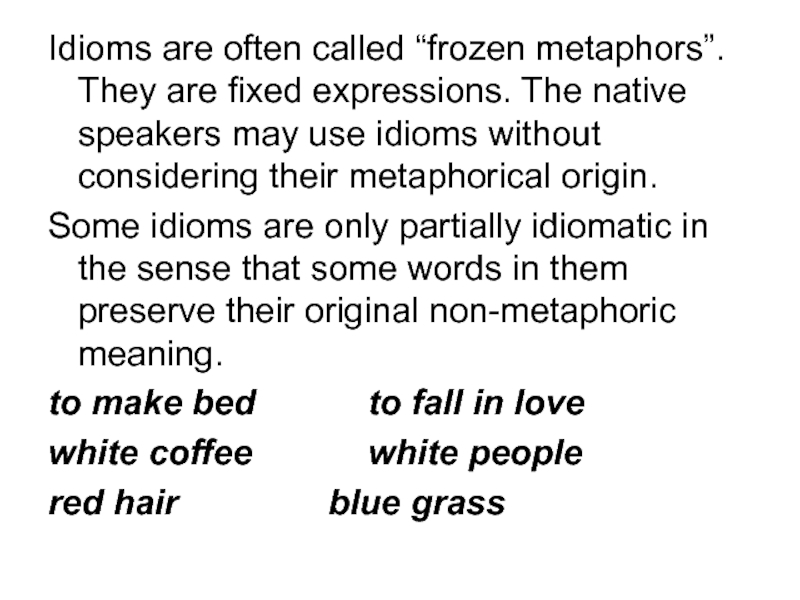
Слайд 25Thus what is and what is not an idiom is a
matter of degree. We can speak about completely non-motivated idioms (Go, fly a kite; to kick the bucket) and partially non-motivated idioms.
Ambiguity of idioms: as expressions many of them may have both literal and non-literal meaning.
to let the cat out of the bag
to wash one’s dirty linen in public
The context helps to disambiguate the use of an idiom.
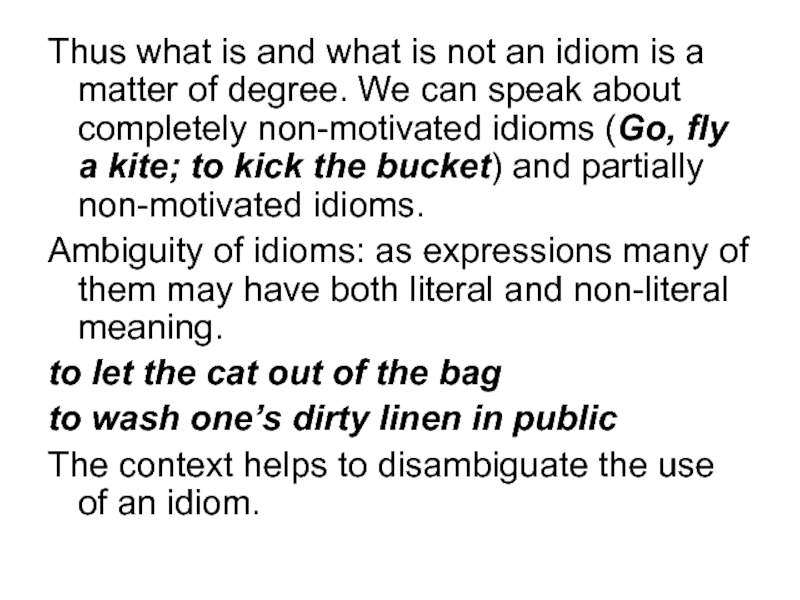
Слайд 26In an idiom in the greatest majority of cases no word
can be replaced by a synonym or any related word. Thus to let the dog/rabbit/ degu/hamster out of the bag will not be treated as an idiom.
Syntactically idioms are mostly strictly fixed – an active form of the expression cannot be changed into a passive, for example (to kick the bucket); words cannot be omitted (to turn over a new leaf).
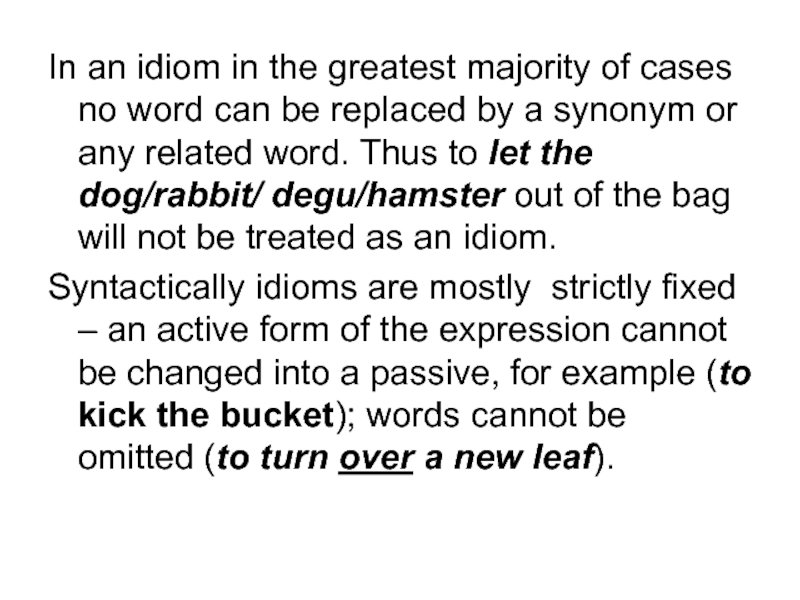
Слайд 27Compound nouns
Not all compound nouns are multiword lexemes.
tablecloth — not
table
manners — multiword lexeme
same-sex (adj) — not
water resistant (adj) — multiword lexeme
travel agency — multiword lexeme
continental breakfast — multiword lexeme
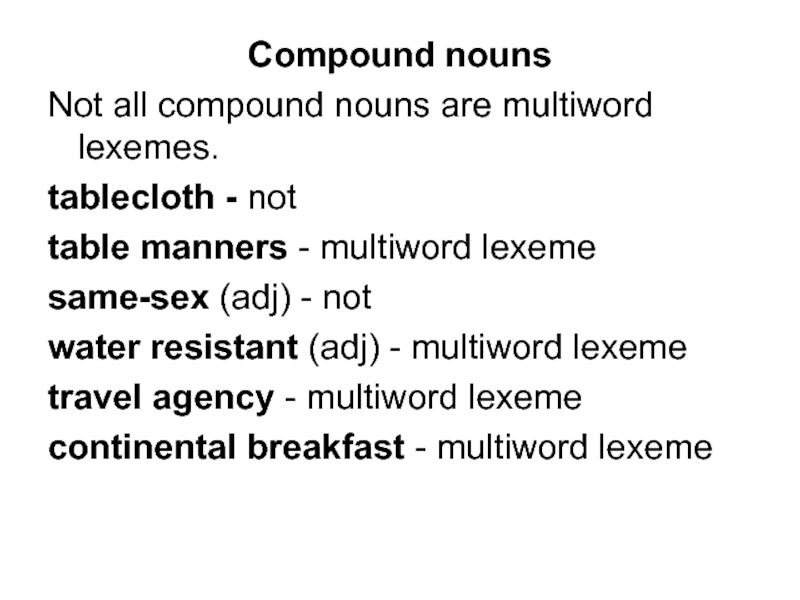
Word Meaning Lecture # 6 Grigoryeva M.
Word Meaning Approaches to word meaning Meaning and Notion (понятие) Types of word meaning Types of morpheme meaning Motivation
Each word has two aspects: the outer aspect ( its sound form) cat the inner aspect (its meaning) long-legged, fury animal with sharp teeth and claws
Sound and meaning do not always constitute a constant unit even in the same language EX a temple a part of a human head a large church
Semantics (Semasiology) Is a branch of lexicology which studies the meaning of words and word equivalents
Approaches to Word Meaning The Referential (analytical) approach The Functional (contextual) approach Operational (information-oriented) approach
The Referential (analytical) approach formulates the essence of meaning by establishing the interdependence between words and things or concepts they denote distinguishes between three components closely connected with meaning: the sound-form of the linguistic sign, the concept the actual referent
Basic Triangle concept – flower concept (thought, reference) – the thought of the object that singles out its essential features referent – object denoted by the word, part of reality sound-form (symbol, sign) – linguistic sign sound-form [rәuz] referent
In what way does meaning correlate with each element of the triangle ? • In what relation does meaning stand to each of them? •
Meaning and Sound-form are not identical different EX. dove — [dΛv] English [golub’] Russian [taube] German sound-forms BUT the same meaning
Meaning and Sound-form nearly identical sound-forms have different meanings in different languages EX. [kot] Russian – a male cat [kot] English – a small bed for a child identical sound-forms have different meanings (‘homonyms) EX. knight [nait]
Meaning and Sound-form even considerable changes in sound-form do not affect the meaning EX Old English lufian [luvian] – love [l Λ v]
Meaning and Concept concept is a category of human cognition concept is abstract and reflects the most common and typical features of different objects and phenomena in the world meanings of words are different in different languages
Meaning and Concept identical concepts may have different semantic structures in different languages EX. concept “a building for human habitation” – English Russian HOUSE ДОМ + in Russian ДОМ “fixed residence of family or household” In English HOME
Meaning and Referent one and the same object (referent) may be denoted by more than one word of a different meaning cat pussy animal tiger
Meaning is not identical with any of the three points of the triangle – the sound form, the concept the referent BUT is closely connected with them.
Functional Approach studies the functions of a word in speech meaning of a word is studied through relations of it with other linguistic units EX. to move (we move, move a chair) movement (movement of smth, slow movement) The distriution ( the position of the word in relation to others) of the verb to move and a noun movement is different as they belong to different classes of words and their meanings are different
Operational approach is centered on defining meaning through its role in the process of communication EX John came at 6 Beside the direct meaning the sentence may imply that: He was late He failed to keep his promise He was punctual as usual He came but he didn’t want to The implication depends on the concrete situation
Lexical Meaning and Notion denotes the Lexical meaning is reflection in the realization of a mind of real objects notion by means of a definite language system Notion is a unit of Word is a language thinking unit
Lexical Meaning and Notions are Meanings are internationally limited especially with the nations of the same EX GO (E) —- ИДТИ(R) cultural level “To move” BUT !!! To GO by bus (E) ЕХАТЬ (R) EX Man -мужчина, человек Она – хороший человек (R) She is a good person (E)
Types of Meaning Types grammatical meaning of meaning lexico-grammatical meaning lexical meaning denotational connotational
Grammatical Meaning component of meaning recurrent in identical sets of individual forms of different words EX. girls, winters, toys, tables – grammatical meaning of plurality asked, thought, walked – meaning of past tense
Lexico-grammatical meaning (part –of- speech meaning) is revealed in the classification of lexical items into: major word classes (N, V, Adj, Adv) minor ones (artc, prep, conj) words of one lexico-grammatical class have the same paradigm
Lexical Meaning is the meaning proper to the given linguistic unit in all its forms and distributions EX. Go – goes — went lexical meaning – process of movement
PRACTICE Group the words into 3 column according to the grammatical, lexical or part-of –speech meaning • • Boy’s, nearest, at, beautiful, think, man, drift, wrote, tremendous, ship’s, the most beautiful, table, near, for, went, friend’s, handsome, thinking, boy, nearer, thought, boys, lamp, go, during.
• Grammatical 1. The case of nouns: boy’s, ship’s, friend’s 2. The degree of comparison of adj: nearest, the most beautiful 3. The tense of verbs: wrote, went, thought • Lexical 1. Think, thinking, thought 2. Went, go 3. Boy’s, boys 4. Nearest, nearer 5. At, for, during (“time”) 6. Beautiful, the most beautiful • Part-of-speech Nouns—verbs—adj—-prep
Aspects of Lexical meaning The denotational aspect The connotational aspect The pragmatic aspect
Denotational Meaning “denote” – to be a sign of, stand as a symbol for” establishes the correlation between the name and the object makes communication possible EX booklet “a small thin book that gives info about smth”
PRACTICE Explain denotational meaning • • A lion-hunter To have a heart like a lion To feel like a lion To roar like a lion To be thrown to the lions The lion’s share To put your head in lion’s mouth
PRACTICE • A lion-hunter A host that seeks out celebrities to impress guests • To have a heart like a lion To have great courage • To feel like a lion To be in the best of health • To roar like a lion To shout very loudly • To be thrown to the lions To be criticized strongly or treated badly • The lion’s share Much more than one’s share • To put your head in lion’s mouth
Connotational Meaning reflects the attitude of the speaker towards what he speaks about it is optional – a word either has it or not Connotation gives additional information and includes: The emotive charge EX Daddy (for father) Intensity EX to adore (for to love) Imagery EX to wade through a book “ to walk with an effort”
PRACTICE Give possible interpretation of the sentences • She failed to buy it and felt a strange pang. • Don’t be afraid of that woman! It’s just barking! • He got up from his chair moving slowly, like an old man. • The girl went to her father and pulled his sleeve. • He was longing to begin to be generous. • She was a woman with shiny red hands and workswollen finger knuckles.
PRACTICE Give possible interpretation of the sentences • She failed to buy it and felt a strange pang. (pain—dissatisfaction that makes her suffer) • Don’t be afraid of that woman! It’s just barking! (make loud sharp sound—-the behavior that implies that the person is frightened) • He got up from his chair moving slowly, like an old man. (to go at slow speed—was suffering or was ill) • The girl went to her father and pulled his sleeve. (to move smth towards oneself— to try to attract smb’s attention) • He was longing to begin to be generous. (to start doing— hadn’t been generous before) • She was a woman with shiny red hands and work-swollen finger knuckles. (colour— a labourer involved into physical work , constant contact with water)
The pragmatic aspect of lexical meaning the situation in which the word is uttered, the social circumstances (formal, informal, etc. ), social relationships between the interlocutors (polite, rough, etc. ), the type and purpose of communication (poetic, official, etc. ) EX horse (neutral) steed (poetic) nag (slang) gee-gee (baby language)
PRACTICE State what image underline the meaning • I heard what she said but it didn’t sink into my mind. • You should be ashamed of yourself, crawling to the director like that. • They seized on the idea. • Bill, chasing some skirt again? • I saw him dive into a small pub. • Why are you trying to pin the blame on me? • He only married her for her dough.
PRACTICE State what image underline the meaning • I heard what she said but it didn’t sink into my mind. • (to understand completely) • You should be ashamed of yourself, crawling to the director like that. (to behave humbly in order to win favour) • They seized on the idea. (to be eager to take and use) • Bill, chasing some skirt again? (a girl) • I saw him dive into a small pub. (to enter suddenly) • Why are you trying to pin the blame on me? (to blame smb unfairly) • He only married her for her dough. (money)
Types of Morpheme Meaning lexical differential functional distributional
Lexical Meaning in Morphemes root-morphemes that are homonymous to words possess lexical meaning EX. boy – boyhood – boyish affixes have lexical meaning of a more generalized character EX. –er “agent, doer of an action”
Lexical Meaning in Morphemes has denotational and connotational components EX. –ly, -like, -ish – denotational meaning of similiarity womanly , womanish connotational component – -ly (positive evaluation), -ish (deragotary) женственный женоподобный
Differential Meaning a semantic component that serves to distinguish one word from all others containing identical morphemes EX. cranberry, blackberry, gooseberry
Functional Meaning found only in derivational affixes a semantic component which serves to refer the word to the certain part of speech EX. just, adj. – justice, n.
Distributional Meaning the meaning of the order and the arrangement of morphemes making up the word found in words containing more than one morpheme different arrangement of the same morphemes would make the word meaningless EX. sing- + -er =singer, -er + sing- = ?
Motivation denotes the relationship between the phonetic or morphemic composition and structural pattern of the word on the one hand, and its meaning on the other can be phonetical morphological semantic
Phonetical Motivation when there is a certain similarity between the sounds that make up the word and those produced by animals, objects, etc. EX. sizzle, boom, splash, cuckoo
Morphological Motivation when there is a direct connection between the structure of a word and its meaning EX. finger-ring – ring-finger, A direct connection between the lexical meaning of the component morphemes EX think –rethink “thinking again”
Semantic Motivation based on co-existence of direct and figurative meanings of the same word EX a watchdog – ”a dog kept for watching property” a watchdog – “a watchful human guardian” (semantic motivation)
• PRACTICE
Analyze the meaning of the words. Define the type of motivation a) morphologically motivated b) semantically motivated • Driver • Leg • Horse • Wall • Hand-made • Careless • piggish
Analyze the meaning of the words. Define the type of motivation a) morphologically motivated b) semantically motivated • Driver Someone who drives a vehicle morphologically motivated • Leg The part of a piece of furniture such as a table semantically motivated • Horse A piece of equipment shaped like a box, used in gymnastics semantically motivated
• Wall Emotions or behavior preventing people from feeling close semantically motivated • Hand-made Made by hand, not machine morphologically motivated • Careless Not taking enough care morphologically motivated • Piggish Selfish semantically motivated
what she said but it didn’t sink in my mind “do down to the bottom” ‘to be accepted by mind” semantic motivation I heard Why are you trying to pin the blame on me? “fasten smth somewhere using a pin” – ”to blame smb” semantic motivation I was following the man when he dived into a pub. “jump into deep water” – ”to enter into suddenly” semantic motivation You should be ashamed of yourself, crawling to the director like that “to move along on hands and knees close to the ground” – “to behave very humbly in order to win favor” semantic motivation










![Meaning and Sound-form are not identical different EX. dove - [dΛv] English [golub’] Russian Meaning and Sound-form are not identical different EX. dove - [dΛv] English [golub’] Russian](https://present5.com/presentation/54919015_285694613/image-10.jpg)
![Meaning and Sound-form nearly identical sound-forms have different meanings in different languages EX. [kot] Meaning and Sound-form nearly identical sound-forms have different meanings in different languages EX. [kot]](https://present5.com/presentation/54919015_285694613/image-11.jpg)







































